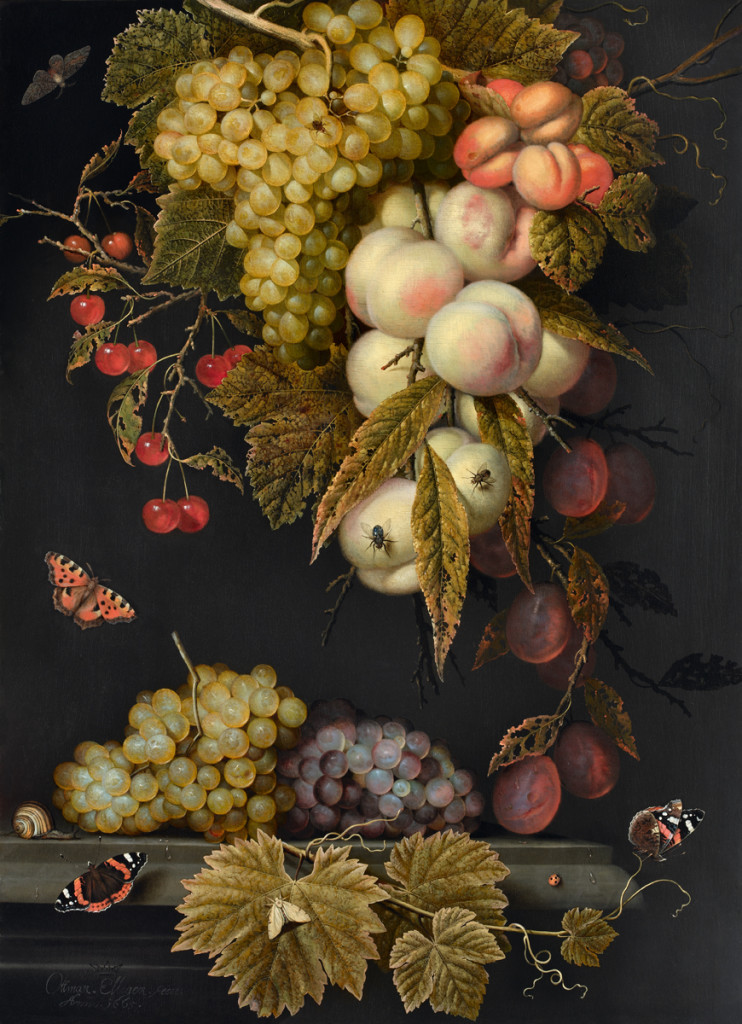Ottmar Elliger the Elder (Göteborg 1633 - 1679 Berlin)
A Garland of Fruit encircled by Insects, 1665
Oil on panel, 64.1 x 46.6 cm
Signed and dated lower left Ottmar. Elliger. Fecit / Anno 1665. A coronet painted above the name ‘Elliger’.[1]
Provenance:
Andreas Cords (1784-1876), Hamburg (until 1815)
Wilhelmine and Louise Marie Sack, Hamburg
Johann Gottfried Schramm Senior, Hamburg (until 1922)
Johann Gottfried Schramm Junior, Hamburg (until 1975)
Thence by descent
Literature:
Niels von Holst, ‘Beiträge zur Geschichte des Sammlertums und des Kunsthandels in
Hamburg von 1700 bis 1840’ in Zeitschrift des Vereins für Hamburgische Geschichte, Hamburg 1939, XXXVIII, p. 277 (titled Trauben, Pfirsiche und Pflaumen)
Arnold Houbraken (1660-1719), Dutch art historian and painter, relates that Ottmar Elliger the Elder was so fascinated by still-life painting that he left his home town of Gothenburg with the specific intention of becoming a pupil of Daniel Seghers (1590-1661) in Antwerp.[2] Seghers was the leading Flemish flower painter of his generation and a specialist in still lifes of garlands. In Antwerp, Elliger also came into contact with, and was strongly influenced by, the work of the Dutch still-life painter Jan Davidsz. de Heem (1606-84). Elliger set up as an independent painter immediately after completing his studies in Antwerp. He moved to Copenhagen in 1654 to work as a court painter in the entourage of King Frederik III of Denmark (1609-70). His portrait of the King, now in the Nationalhistoriske Museum at Frederiksborg Castle, is framed with a decorative garland of fruit and flowers. Records show that Elliger was in Amsterdam in 1657 and that he married Anthonia van Walscapelle, the sister of the still-life painter Jakob van Walscapelle (1644-1727), in 1660. He moved to Hamburg in the early 1660s and although the exact date is not recorded it is probable that he was already established in the city by the year 1665, when he executed the present painting. Records also show that Elliger’s son, Ottmar the Younger,[3] was born in Hamburg in 1666. Hamburg ownership of the present work is well-documented and can be traced back to the early nineteenth century. Elliger the Elder was appointed as court painter to Frederick William, Elector of Brandenburg (1620-88) in 1670 and moved to Berlin, where he died in 1679. Although he also worked in other genres he is best known for his outstanding achievement in still-life painting.
Flower still-life painting was particularly popular in seventeenth-century Hamburg. Around the city, wealthy owners of country houses and gardens – designed in English and Dutch style – indulged their horticultural enthusiasms by cultivating rare and costly plants.[4]
Elliger was at the height of his career when he executed the present work in Hamburg in 1665. The painting is in extraordinarily fine condition. The dark background forms a powerful contrast with the rich tones of the fruit and the insects. The delicacy of the brushwork recalls de Heem’s skilful techniques. The garland is composed of white peaches, grapes, cherries, plums and apricots. Butterflies – a Red Admiral (Vanessa atalanta) and a Small Tortoiseshell (Aglais urticae) – together with moths, ladybirds, flies and snails fill the image. Two bunches of grapes – white and purple – are laid out on a marble base below the garland. Some of the fruit is overripe. Traces of bruises and decay are evident. A distinctive element of Elliger’s palette is the use of vivid yellows and greens, employed here in the depiction of the leaves. These display signs of insect damage. Indications of decay and damage are characteristic of Baroque still life. They reference the Vanitas theme and point to the ephemeral nature of existence.
Still lifes by Ottmar Elliger are held in many of Europe’s leading public collections. These include the Staatliche Museen zu Berlin; the Rijksmuseum, Amsterdam; the Kunsthalle Hamburg; the Gemäldegalerie Dresden; the Statens Museum in Copenhagen; and the Ashmolean Museum in Oxford.
[1] Similar coronets appear in a number of other works by Elliger. One example is the painting titled, Garland of Fruit and Foliage, 1666, oil on oak panel, 64 x 44 cm, signed and dated lower right Ottmar Elliger fecit anno 1666, Braunschweig, Herzog Anton Ulrich-Museum, inv. 555.
[2] P. T. A. Swillens (ed.), De Groote Schouburgh der Nederlantsche Konstschilders en Schilderessen door Arn. Houbraken, II, Maastricht 1944, p. 230.
[3] Ottmar Elliger the Younger (1666-1732) specialized in history painting and also worked as an engraver in Amsterdam. See Carmen Roll, Ottmar Elliger d.J. (1666-1732). Leben und Werk, Diss., 3 vols., Augsburg 2002.
[4] See Stephanie Hauschild, ‘«Planten un Blomen». Zur Geschichte des Blumenbildes in Hamburg’, in Dietrich Roth (ed.), Die Blumenbücher des Hans Simon Holtzbecker und Hamburgs Lustgärten, symposium report and exhib. cat., Hamburg University Library, Keltern-Weiler 2003, p. 130.

